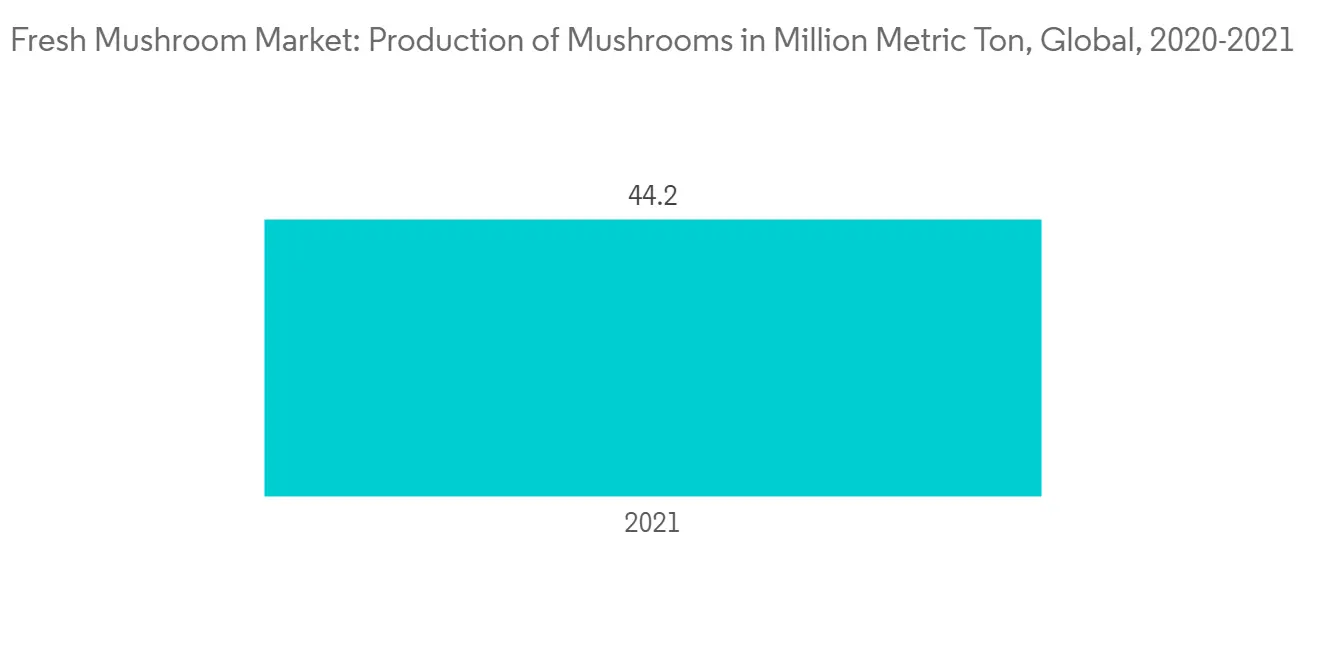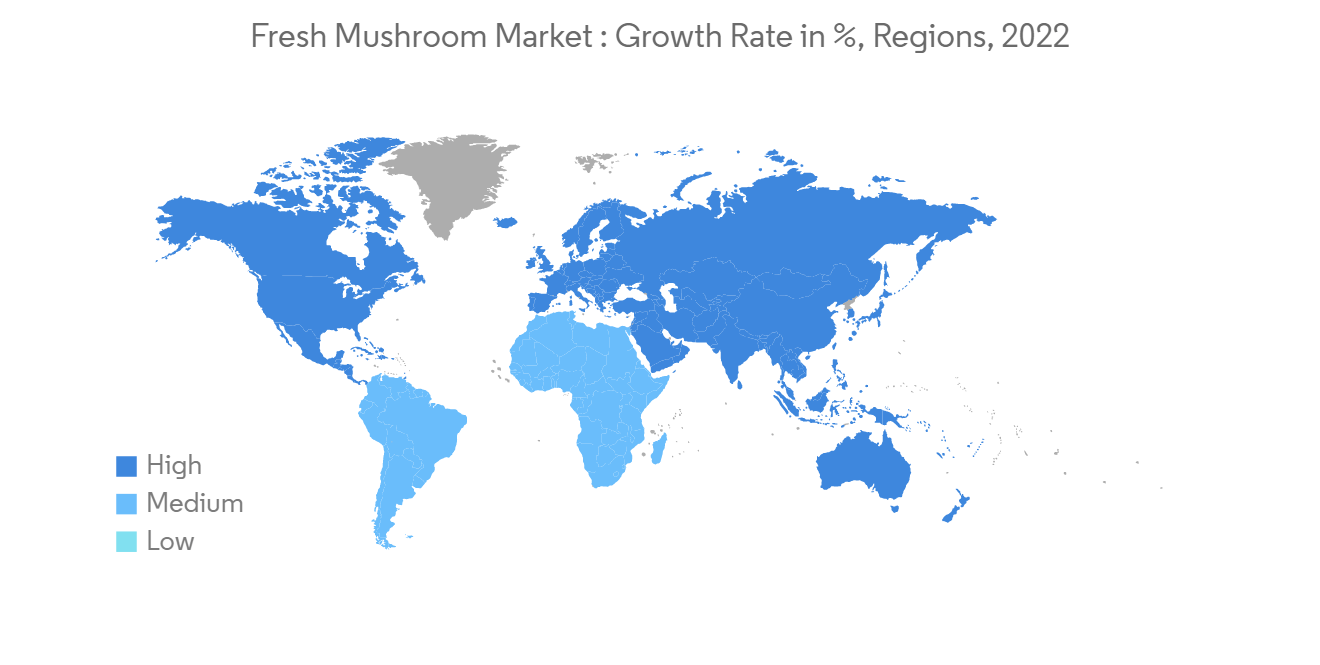 |
市場調查報告書
商品編碼
1273336
新鮮蘑菇市場 - COVID-19 的增長、趨勢、影響和預測 (2023-2028)Fresh Mushrooms Market - Growth, Trends, and Forecasts (2023 - 2028) |
||||||
※ 本網頁內容可能與最新版本有所差異。詳細情況請與我們聯繫。
在預測期內,新鮮蘑菇市場的複合年增長率預計為 2%。
主要亮點
- 亞太地區是最大的新鮮蘑菇消費市場,而中國是世界上最大的新鮮蘑菇生產國。 波蘭將成為 2021 年最大的蘑菇出口國,出口價值 469,000 美元的新鮮蘑菇,其次是加拿大和荷蘭。 新鮮蘑菇的最大進口國是美國,進口價值 348,000 美元的蘑菇,其次是英國和德國。 驅動因素之一可能是人們對富含微量營養素並支持免疫系統的藥用蘑菇越來越感興趣。 德國、意大利、法國、英國、荷蘭和波蘭是為發展中國家供應商提供最大機會的國家。
- 根據美國農業部的說法,蘑菇 R&P 計劃作為蘑菇委員會運作,以維護和擴大現有的蘑菇市場和用途。 該計劃由蘑菇委員會管理,該委員會由 AMS 監督,由同行提名並由農業部長任命的蘑菇行業代表組成。 委員會收集在美國 50 個州、波多黎各和哥倫比亞特區生產或進口的新鮮市場蘑菇的估價。 平均而言,對每年生產或進口超過 500,000 磅蘑菇的生產商和進口商進行評估。
- 作為市場驅動力,蘑菇的高回報,特別是對土地稀缺的種植者而言,以及蘑菇種植的巨大普及,以及從消費者的角度來看,新鮮蘑菇的營養需求正在增加,因為它們的高價格。
新鮮蘑菇市場趨勢
健康意識的提高促進蘑菇消費
蘑菇熱量低,但營養豐富,含有許多維持身體健康的重要營養素,例如維生素、礦物質和抗氧化劑。 例如,紫外線生長的蘑菇富含維生素 D,這是骨骼和免疫健康的重要組成部分。 蘑菇的營養價值因品種而異。 Crimini 蘑菇是一種特別好的鋅來源,鋅是一種必需的微量元素。 鋅是免疫系統的必需營養素,也是確保嬰幼兒最佳生長所必需的。 據糧農組織稱,由於蘑菇的全球效益,全球蘑菇產量比 2020 年增加了 4420 萬噸。 這些因素推動了消費者對蘑菇的需求,這種需求在未來幾年將繼續增長。
2022 年,加拿大政府宣布向加拿大蘑菇投資高達 344,100 美元,以支持加拿大蘑菇行業的市場增長。 根據農產品營銷計劃,加拿大蘑菇協會將使用這筆資金向消費者和利益相關者宣傳蘑菇的營養價值。 該項目旨在通過行業主導的促銷活動,維持和增長加拿大蘑菇在國內和美國的需求和消費。
除了素食者的快速增加之外,由於越來越多地使用肉類作為肉類的替代品,市場有望擴大。 由於計算機控制、疾病預測傳感器、自動蘑菇收割機和自動溫度控制系統等現代技術的進步,蘑菇產量也急劇增加。 這將加強未來的市場增長。

亞太地區主導市場
亞太地區是最大的新鮮蘑菇市場區域。 中國是最大的鮮菇消費國和生產國之一,佔全球鮮菇產量的近52%。 亞太地區的其他大型市場包括日本、印度、馬來西亞和韓國。 由於韓國生產商眾多,國內價格往往較低,迫使韓國生產商尋求國際市場。 繼亞太地區之後,鮮菇的主要產地是歐洲、美洲和非洲。
除了海外擴張,在主要國家,勞動密集型蘑菇切割旨在減少 150 多名工人的生產和包裝工作,並在更短的時間內生產大量蘑菇。我們正在尋求自動化以提高效率通過在此過程中使用配備人工智能的機器。 據糧農組織稱,2021年中國的產量將達到4110萬噸,比上年有所增加。
日本是世界上最大的松茸蘑菇消費國,其國內收穫的大部分松茸都留作家庭消費,並從中國進口大量松茸。 據日本農林水產省稱,由於松茸具有最大的健康益處,中國的中產階級消費者也越來越喜歡松茸。 這將有助於該地區的市場在未來進一步發展。

鮮菇行業概況
其他福利:
- Excel 格式的市場預測 (ME) 表
- 3 個月的分析師支持
內容
第一章介紹
- 調查假設和市場定義
- 本次調查的範圍
第二章研究方法論
第 3 章執行摘要
第四章市場動態
- 市場概覽
- 市場驅動力
- 市場製約因素
- 價值鏈分析
第 5 章市場細分
- 地區
- 北美
- 加拿大
- 生產分析
- 消費市場分析和市場價值
- 進口市場分析(數量和價值)
- 出口市場分析(數量和價值)
- 價格趨勢分析
- 美國
- 生產分析
- 消費市場分析和市場價值
- 進口市場分析(數量和價值)
- 出口市場分析(數量和價值)
- 價格趨勢分析
- 墨西哥
- 生產分析
- 消費市場分析和市場價值
- 進口市場分析(數量和價值)
- 出口市場分析(數量和價值)
- 價格趨勢分析
- 歐洲
- 英國
- 生產分析
- 消費市場分析和市場價值
- 進口市場分析(數量和價值)
- 出口市場分析(數量和價值)
- 價格趨勢分析
- 荷蘭
- 生產分析
- 消費市場分析和市場價值
- 進口市場分析(數量和價值)
- 出口市場分析(數量和價值)
- 價格趨勢分析
- 意大利
- 生產分析
- 消費市場分析和市場價值
- 進口市場分析(數量和價值)
- 出口市場分析(數量和價值)
- 價格趨勢分析
- 德國
- 生產分析
- 消費市場分析和市場價值
- 進口市場分析(數量和價值)
- 出口市場分析(數量和價值)
- 價格趨勢分析
- 愛爾蘭
- 生產分析
- 消費市場分析和市場價值
- 進口市場分析(數量和價值)
- 出口市場分析(數量和價值)
- 價格趨勢分析
- 波蘭
- 生產分析
- 消費市場分析和市場價值
- 進口市場分析(數量和價值)
- 出口市場分析(數量和價值)
- 價格趨勢分析
- 亞太地區
- 中國
- 產量分析
- 消費市場分析和市場價值
- 進口市場分析(數量和價值)
- 出口市場分析(數量和價值)
- 價格趨勢分析
- 印度
- 生產分析
- 消費市場分析和市場價值
- 進口市場分析(數量和價值)
- 出口市場分析(數量/價值)
- 價格趨勢分析
- 日本
- 生產分析
- 消費市場分析和市場價值
- 進口市場分析(數量和價值)
- 出口市場分析(數量和價值)
- 價格趨勢分析
- 南美洲
- 智利
- 生產分析
- 消費市場分析和市場價值
- 進口市場分析(數量和價值)
- 出口市場分析(數量和價值)
- 價格趨勢分析
- 巴西
- 生產分析
- 消費市場分析和市場價值
- 進口市場分析(數量和價值)
- 出口市場分析(數量和價值)
- 價格趨勢分析
- 中東和非洲
- 土耳其人
- 生產分析
- 消費市場分析和市場價值
- 進口市場分析(數量/價格)
- 出口市場分析(數量/價值)
- 價格趨勢分析
- 南非
- 生產分析
- 消費市場分析和市場價值
- 進口市場分析(數量和價值)
- 出口市場分析(數量/價值)
- 價格趨勢分析
- 北美
第六章市場機會與未來趨勢
The fresh mushroom market is projected to register a CAGR of 2% during the forecast period.
Key Highlights
- Asia-Pacific is the largest market for fresh mushroom consumption, and China is the largest producer of fresh mushrooms in the world. In 2021, the top mushroom exporters were Poland, which exported fresh mushrooms worth USD 469 thousand, followed by Canada and the Netherlands. The top importers of fresh mushrooms were the United States, which imported USD 348 thousand worth of mushrooms, followed by the United Kingdom and Germany. One of the driving forces would be increased interest in medical mushrooms as they are rich in micronutrients and support the immune system. Germany, Italy, France, the United Kingdom, the Netherlands and Poland offer the most opportunities for developing country suppliers.
- According to the US Department of Agriculture, the mushroom R&P program operates as the Mushroom Council to maintain and expand existing mushroom markets and uses. The program is administered under AMS oversight by the Mushroom Council, composed of mushroom industry representatives nominated by their peers and appointed by the Secretary of Agriculture. The Council collects assessments on fresh market mushrooms produced in or imported into the 50 States, Puerto Rico, and the District of Columbia. On average, producers and importers who produce or import more than 500,000 pounds of mushrooms annually are assessed.
- Some factors driving the market are high returns generated from mushrooms, especially for cultivators with insufficient land, their cultivation is gaining immense popularity, and even from the consumer perspective, the demand for fresh mushrooms is increasing due to their nutritional value globally.
Fresh Mushrooms Market Trends
Rising Health Consciousness to Propel Mushroom Consumption
Mushrooms are a low-calorie food that packs a nutritional punch and is loaded with many health-boosting vitamins, minerals, and antioxidants, which are important parts of any diet. For instance, mushrooms raised with exposure to ultraviolet light are a good source of vitamin D, an important component in bone and immune health. Different varieties of mushrooms have different nutritional values. Among them, Crimini mushrooms are a particularly excellent source of zinc, an essential trace element. Zinc is a vital nutrient for the immune system and is also needed for ensuring optimal growth in infants and children. According to FAO, the global production of mushrooms increased by 44.2 million metric tons compared to 2020 due to the huge benefits of mushrooms globally. These factors are boosting the demand for mushrooms in the consumers and tend to grow in the following years.
In 2022, the Government of Canada announced an investment of up to USD 344,100 for the Canadian Mushroom Growers' Association (Mushrooms Canada) to support market growth for Canada's mushroom sector. Under the Agri Marketing Program, funds are being utilized to help Mushrooms Canada increase consumer and stakeholder knowledge of the nutritional benefits of mushrooms. The funded project aims to maintain and expand Canadian mushroom demand and consumption domestically and in the United States through industry-led promotional activities.
The burgeoning vegan population, combined with increasing usage as a meat alternative, is expected to fuel market expansion, and the latest technological advancements, such as computerized control, disease forecasting sensors, automated mushroom harvesters, and automated temperature-controlling systems, have also increased mushroom production drastically. This is strengthening the market to grow in the future.

Asia-Pacific Dominates the Market
Asia-Pacific is the largest market region for fresh mushrooms. China is one of the largest consumers and producers of fresh mushrooms, accounting for nearly 52% of the world's fresh mushroom production. The other large markets in Asia-Pacific include Japan, India, Malaysia, and South Korea. Due to the large number of producers in South Korea, domestic prices are often low, making the producers from the country look for opportunities in the international market. The other large producers of fresh mushrooms after Asia-Pacific include Europe, America and Africa.
Besides its overseas expansion, major countries are turning to automation to improve efficiency with machinery equipped with artificial intelligence for the labor-intensive process of cutting mushrooms which aims to reduce more than 150 workers from production and packaging operations to produce large quantities of mushrooms in less time. According to FAO, China's production accounted for 41.1 million metric ton in 2021, which has increased compared to the previous year.
Japan is the world's largest consumer of matsutake, reserves almost all domestic harvest for its own consumption and imports a large haul from China. According to Japan's Agriculture Ministry, middle-class Chinese consumers are also increasingly acquiring a taste for the mushroom due to the maximum health benefits of the matsutake mushroom. This will help the market in the region to grow further in the future.

Fresh Mushrooms Industry Overview
Additional Benefits:
- The market estimate (ME) sheet in Excel format
- 3 months of analyst support
TABLE OF CONTENTS
1 INTRODUCTION
- 1.1 Study Assumptions and Market Definition
- 1.2 Scope of the Study
2 RESEARCH METHODOLOGY
3 EXECUTIVE SUMMARY
4 MARKET DYNAMICS
- 4.1 Market Overview
- 4.2 Market Drivers
- 4.3 Market Restraints
- 4.4 Value Chain Analysis
5 MARKET SEGMENTATION
- 5.1 Geography
- 5.1.1 North America
- 5.1.1.1 Canada
- 5.1.1.1.1 Production Analysis
- 5.1.1.1.2 Consumption Analysis and Market Value
- 5.1.1.1.3 Import Market Analysis (Volume and Value)
- 5.1.1.1.4 Export Market Analysis (Volume and Value)
- 5.1.1.1.5 Price Trend Analysis
- 5.1.1.2 United States
- 5.1.1.2.1 Production Analysis
- 5.1.1.2.2 Consumption Analysis and Market Value
- 5.1.1.2.3 Import Market Analysis (Volume and Value)
- 5.1.1.2.4 Export Market Analysis (Volume and Value)
- 5.1.1.2.5 Price Trend Analysis
- 5.1.1.3 Mexico
- 5.1.1.3.1 Production Analysis
- 5.1.1.3.2 Consumption Analysis and Market Value
- 5.1.1.3.3 Import Market Analysis (Volume and Value)
- 5.1.1.3.4 Export Market Analysis (Volume and Value)
- 5.1.1.3.5 Price Trend Analysis
- 5.1.2 Europe
- 5.1.2.1 United Kingdom
- 5.1.2.1.1 Production Analysis
- 5.1.2.1.2 Consumption Analysis and Market Value
- 5.1.2.1.3 Import Market Analysis (Volume and Value)
- 5.1.2.1.4 Export Market Analysis (Volume and Value)
- 5.1.2.1.5 Price Trend Analysis
- 5.1.2.2 Netherlands
- 5.1.2.2.1 Production Analysis
- 5.1.2.2.2 Consumption Analysis and Market Value
- 5.1.2.2.3 Import Market Analysis (Volume and Value)
- 5.1.2.2.4 Export Market Analysis (Volume and Value)
- 5.1.2.2.5 Price Trend Analysis
- 5.1.2.3 Italy
- 5.1.2.3.1 Production Analysis
- 5.1.2.3.2 Consumption Analysis and Market Value
- 5.1.2.3.3 Import Market Analysis (Volume and Value)
- 5.1.2.3.4 Export Market Analysis (Volume and Value)
- 5.1.2.3.5 Price Trend Analysis
- 5.1.2.4 Germany
- 5.1.2.4.1 Production Analysis
- 5.1.2.4.2 Consumption Analysis and Market Value
- 5.1.2.4.3 Import Market Analysis (Volume and Value)
- 5.1.2.4.4 Export Market Analysis (Volume and Value)
- 5.1.2.4.5 Price Trend Analysis
- 5.1.2.5 Ireland
- 5.1.2.5.1 Production Analysis
- 5.1.2.5.2 Consumption Analysis and Market Value
- 5.1.2.5.3 Import Market Analysis (Volume and Value)
- 5.1.2.5.4 Export Market Analysis (Volume and Value)
- 5.1.2.5.5 Price Trend Analysis
- 5.1.2.6 Poland
- 5.1.2.6.1 Production Analysis
- 5.1.2.6.2 Consumption Analysis and Market Value
- 5.1.2.6.3 Import Market Analysis (Volume and Value)
- 5.1.2.6.4 Export Market Analysis (Volume and Value)
- 5.1.2.6.5 Price Trend Analysis
- 5.1.3 Asia-Pacific
- 5.1.3.1 China
- 5.1.3.1.1 Production Analysis
- 5.1.3.1.2 Consumption Analysis and Market Value
- 5.1.3.1.3 Import Market Analysis (Volume and Value)
- 5.1.3.1.4 Export Market Analysis (Volume and Value)
- 5.1.3.1.5 Price Trend Analysis
- 5.1.3.2 India
- 5.1.3.2.1 Production Analysis
- 5.1.3.2.2 Consumption Analysis and Market Value
- 5.1.3.2.3 Import Market Analysis (Volume and Value)
- 5.1.3.2.4 Export Market Analysis (Volume and Value)
- 5.1.3.2.5 Price Trend Analysis
- 5.1.3.3 Japan
- 5.1.3.3.1 Production Analysis
- 5.1.3.3.2 Consumption Analysis and Market Value
- 5.1.3.3.3 Import Market Analysis (Volume and Value)
- 5.1.3.3.4 Export Market Analysis (Volume and Value)
- 5.1.3.3.5 Price Trend Analysis
- 5.1.4 South America
- 5.1.4.1 Chile
- 5.1.4.1.1 Production Analysis
- 5.1.4.1.2 Consumption Analysis and Market Value
- 5.1.4.1.3 Import Market Analysis (Volume and Value)
- 5.1.4.1.4 Export Market Analysis (Volume and Value)
- 5.1.4.1.5 Price Trend Analysis
- 5.1.4.2 Brazil
- 5.1.4.2.1 Production Analysis
- 5.1.4.2.2 Consumption Analysis and Market Value
- 5.1.4.2.3 Import Market Analysis (Volume and Value)
- 5.1.4.2.4 Export Market Analysis (Volume and Value)
- 5.1.4.2.5 Price Trend Analysis
- 5.1.5 Middle East & Africa
- 5.1.5.1 Turkey
- 5.1.5.1.1 Production Analysis
- 5.1.5.1.2 Consumption Analysis and Market Value
- 5.1.5.1.3 Import Market Analysis (Volume and Value)
- 5.1.5.1.4 Export Market Analysis (Volume and Value)
- 5.1.5.1.5 Price Trend Analysis
- 5.1.5.2 South Africa
- 5.1.5.2.1 Production Analysis
- 5.1.5.2.2 Consumption Analysis and Market Value
- 5.1.5.2.3 Import Market Analysis (Volume and Value)
- 5.1.5.2.4 Export Market Analysis (Volume and Value)
- 5.1.5.2.5 Price Trend Analysis
- 5.1.1 North America













